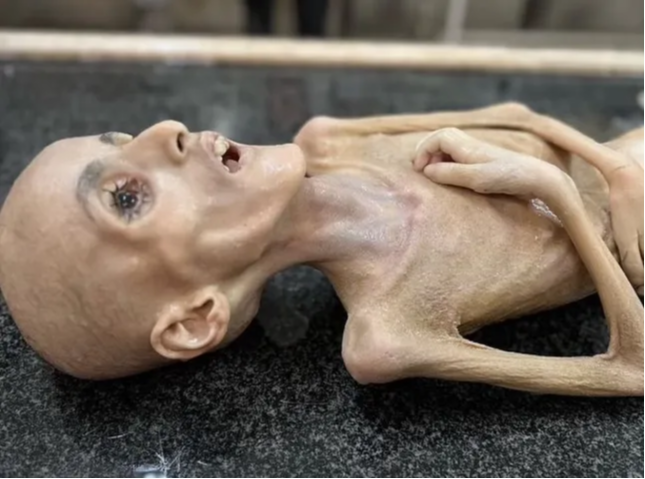
Dying of hunger in Rafah (Photo: AP)
Rafah, June 15 (RHC)--Two Palestinian toddlers with sunken eyes and emaciated faces, one in a yellow cardigan and the other in a stripy top, were lying side by side on a bed in a Gaza clinic, their thin, bony legs protruding from diapers that looked too big for them, Reuters reports.
This was the scene at Al-Awda Health Center in Rafah, southern Gaza, where Nurse Diaa Al-Shaer said children suffering from malnutrition and from a range of diseases were arriving in unprecedented numbers.
“We will face a large number of patients who suffer from this, which is malnutrition,” she said.
The toddler in the yellow cardigan, Ahmed Qannan, weighed 6 kg (13.2 lb), half of his pre-war body weight, according to his aunt, Israa Kalakh, who was by his side. “His situation worsens each day. God protect us from what is coming,” she told Reuters.
Nearly five months into Israel’s air and ground assault on the Gaza Strip and resulting mass displacement, acute shortages of food have led to what the United Nations is describing as a nutrition crisis, part of a wider humanitarian catastrophe.
Gaza’s Health Ministry said that 15 children had died this past week of malnutrition or dehydration at Kamal Adwan Hospital in Beit Lahiya, northern Gaza, the part of the enclave where the lack of food is most extreme. “The unofficial numbers can unfortunately be expected to be higher,” said World Health Organization spokesperson, Christian Lindmeier.
The worsening hunger crisis has intensified criticism of Israel on the world stage, including from U.S. Vice President Kamala Harris, whose country is Israel’s staunchest ally. She is quoted as saying that "people in Gaza are starving," calling on Israel to do more to significantly increase the flow of aid.
Reuters obtained video filmed on last week at Kamal Adwan, showing a woman, Anwar Abdulnabi, weeping over the body of her daughter, Mila, a toddler, who had just died in her bed.
“My daughter, my beautiful daughter, my gentle daughter has passed away,” cried Abdulnabi. She later said through her tears that Mila had been suffering from calcium and potassium deficiencies, but did not specify what caused the child’s death.
Dr Ahmad Salem, who works in the Hospital’s intensive care unit, said one of the factors in the high number of child deaths there was that new mothers were themselves malnourished. “The mothers cannot breastfeed their children. We do not have formula milk. This has led to the deaths of children here in the intensive care unit. Also in the nursery, there are numerous deaths,” he said.
Deliveries of food aid to the whole of Gaza are falling far short of what is needed, and the problem is worse in the north because the only crossings where Israel allows only a few trucks to pass are in the south. Some aid trucks have been seized by desperate crowds before they reach the north.
“The sense of helplessness and despair among parents and doctors in realizing that life-saving aid, just a few kilometres away, is being kept out of reach, must be unbearable,” said Adele Khodr, UNICEF regional director for the Middle East and North Africa.
In its latest situation report, the UN agency for Palestinian refugees, UNRWA, said an average of about 97 trucks a day had been entering Gaza in February, down from about 150 in January and well short of the 500-a-day target.
UN agencies and humanitarian groups have blamed the shortfall on Israel’s actions, including the closure of land crossings into northern Gaza, ongoing military operations and a complex system of Israeli checks of items bound for Gaza.
Israel claims it does not restrict humanitarian or medical aid and has blamed the lack of deliveries on the capacity of aid agencies.
More broadly, Israel blames the Palestinian group, Hamas, for starting the war by launching an attack on
southern Israel on 7 October in which its fighters killed 1,200 people and took 253 hostages. It also accuses Hamas of using Gaza’s civilian population as human shields.
However, since then, it has been revealed by Haaretz that helicopters and tanks of the Israeli army had, in fact, killed many of the 1,139 soldiers and civilians claimed by Israel to have been killed by the Palestinian Resistance.
Israel’s air and ground assault on Gaza has killed more than 30,000 Palestinians there, according to local health officials.
Back at Al-Awda Health Center in Rafah, a 12-year-old boy named Yazan Al-Kafarna died on Monday. Filmed for Reuters on Saturday, he was pale and emaciated, with skeletal limbs.
Dr Jabir Al-Shaar, head of the paediatric department at Abu Yousef Al-Najar Hospital in Rafah, where the boy was treated until he was transferred to Al-Awda, said Yazan had cerebral palsy and had been dependent upon a special diet such as blended fruit and milk, items now unavailable in Gaza.
The doctor attributed the boy’s death to malnutrition. The case was already becoming a cause celebre on Monday, being cited at a meeting of the UN General Assembly by Palestinian envoy, Riyad Mansour.
His mother, Um Yazan Al-Kafarna, spent the last days of his life by his side. “He used to eat, drink, move, play, laugh. I used to play with him,” she said.

